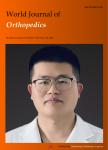Olecranon anatomy:Use of a novel proximal interlocking screw for intramedullary nailing,a cadaver study
Olecranon anatomy:Use of a novel proximal interlocking screw for intramedullary nailing,a cadaver study作者机构:Department of Orthopedics and TraumatologyBezmialem Vakif University34093 IstanbulTurkey Department of Orthopedics and TraumatologyUmraniye Research and Education Hospital34764 IstanbulTurkey Department of Orthopaedics and TraumatologyAdiyaman University School of Medicine02040 AdiyamanTurkey Department of Orthopedics and TraumatologyAbant Izzet Baysal University14280 BoluTurkey
出 版 物:《World Journal of Orthopedics》 (世界骨科杂志(英文版))
年 卷 期:2013年第4卷第3期
页 面:130-133页
学科分类:10[医学]
主 题:Interlocking screw Intramedullary nailing Ulna fracture Ulna anatomy
摘 要:AIM: To define the optimum safe angle of use for an eccentrically aligned proximal interlocking screw(PIS) for intramedullary nailing(IMN).METHODS: Thirty-six dry cadaver ulnas were split into two equal pieces sagitally. The following points were identified for each ulna: the deepest point of the incisura olecrani(A), the point where perpendicular lines from A and the ideal IMN entry point(D) are intersected(C) and a point at 3.5 mm(2 mm safety distance from articular surface + 1.5 mm radius of PIS) posterior from point A(B). We calculated the angle of screws inserted from point D through to point B in relation to D-C and B-C. In addition, an eccentrically aligned screw was inserted at a standard 20° through the anterior cortex of the ulna in each bone and the articular surface wasobserved macroscopically for any ***: The mean A-C distance was 9.6 mm(mean ± SD, 9.600 ± 0.763 mm), A-B distance was 3.5 mm, C-D distance was 12.500 mm(12.500 ± 1.371 mm) and the mean angle was 25.9°(25.9°± 2.0°). Lack of articular damage was confirmed macroscopically in all bones after the 20.0° eccentrically aligned screws were inserted. Intramedullary nail fixation systems have well known biological and biomechanical advantages for osteosynthesis. However, as well as these well-known advantages, IMN fixation of the ulna has some limitations. Some important limitations are related to the proximal interlocking of the ulna nail. The location of the PIS itself limits the indications for which intramedullary systems can be selected as an implant for the ulna. The new PIS design, where the PIS is aligned 20°eccentrically to the nail body, allows fixing of fractures even at the level of the olecranon without disturbing the joint. It also allows the eccentrically aligned screw to be inserted in any direction except through the proximal radio-ulnar joint. Taking into consideration our results, we now use a 20° eccentrically aligned PIS for all ulnas. In our results, the angle require




